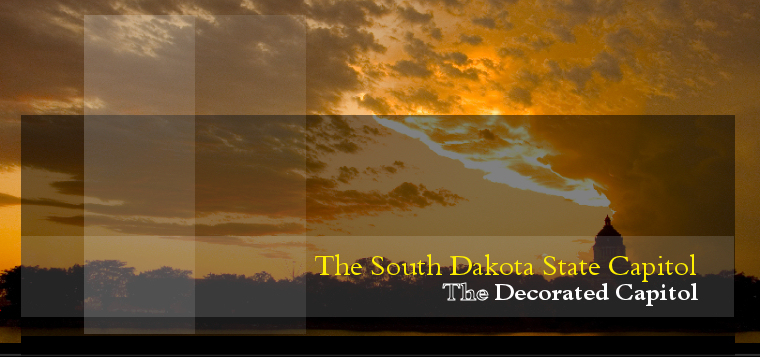|
Charles Holloway was the artist commissioned to paint three murals in the completed Capitol building. Not much is written of the man before his days spent in South Dakota painting the three murals he had been commissioned for; The Mercy of the Law, The Louisiana Purchase, and the Peace that Passes Understanding.
After his South Dakota Mural days, Holloway was active in San Francisco during 1914-15 as a muralist for the Panama - Pacific International Exposition. By 1920 he was working in Los Angeles. Holloway was mainly active in Illinois and California. If you review some of his works, he was a very prolific muralist, whose work can be viewed in Capitols and courthouses nationwide.
The painting known as Mercy of the Law (as pictured in Black and White) resides in the Supreme Court chambers.
Curiously enough, during a period of time as documented in the 1970's and 1980's, this painting was also referred to as "the Gate of Justice." However, in earlier Capitol Guides, and as revised after the Capitol Renovations, it has been properly known as "The Mercy of the Law."
Flanked by the lion, symbols of courage, stern guardians armed with swords guard the gates of Justice. On the walls by the gates are the sculpted figures of "Law" and "Justice."
On each side of the lower part of the painting is shown the despairing and remorseful guilty. In the center is the spirit of Mercy showing compassion and pity for the guilty, but as the guardian of nature's law, the strong arm of God, she demands their penalty.
One thing that should not escape the visitor's attention is that the Holloway paintings are of a more classical nature, as was the style with other popular artists of the day such as Maxfield Parish. These are the only murals with that type of artistry (which will include semi-nude depictions) that you'll find in the Capitol. Over the building's nearly hundred years, that fact has not gone unnoticed.
At one time in the 1980's, a resolution had been introduced in the Legislature to cover the Holloway mural in the State Senate chamber, known as "the Louisiana Purchase" as pictured below:
This measure did not pass the Senate, and the mural has remained on display to this day.
Before it was hung in the Capitol, the Louisiana Purchase Mural was originally painted to enter into the competition at the St. Louis Fair for the best design illustrating the Louisiana Purchase. According to file information, this painting won the first award and a prize of $3,000 - a princely sum for the day. In 2006 dollars, it would have been a roughly $50,000 prize.
According to the 1920 brochure Guide to South Dakota Capitol "This painting was purchased by the Capitol Commission as exceedingly appropriate for this Capitol."
The final Holloway mural, The Peace That Passes Understanding, looks down upon the South Dakota House of Representatives, and represents the first recorded act of Christian worship in South Dakota, the celebrated Jedediah Smith incident of 1823.
(The Peace That Passes Understanding as it appeared during the Capitol Restoration)
According to source material used in Capitol Tours and guides of the past:
The largest mural in the Capitol notes the time in South Dakota's history when 23 men under the command of General Ashley had been ambushed by the Ree at the towns near the present city of Mobridge, their dead and dying bodies were brought on to the little trading boat. The moorings were cut, and they drifted downstream. The men were so overcome by the loss that they would not attempt to fight their way past the hostile Indian town.
Ashley, feeling it was imperative to communicate with his partner, Major Andrew Henry on the Yellowstone, called for volunteers to make the perilous trip of 400 miles through the wilderness. Jedediah Smith volunteered and before starting knelt among them and "made a powerful prayer, which moved us all greatly." In the painting, Holloway combines historical fact with symbolism.
In the center, Smith is shown praying to God for the dead and dying. Native Americans are shown among the willows on the shore, among them a chief demanding peace. In the foreground, and Indian maiden looking to the sky feels the wonder of life, and sees it, as do the others of her tribe.
As Jedidiah Smith calls down the blessing of heaven upon the dying, his spiritual force produces a power over the Indians. They see the spirit of the heavens above as they saw the spirits of their dead. The fight is over and to all comes the unifying "peace that passes understanding."
(from Guide to South Dakota Capitol, 1920's, and State Capitol of South Dakota, Dayton Canaday).
This brings us to the most celebrated mural in the South Dakota State Capitol, as well as the most controversial. It's a painting that - until conservation methods are available to move it from the Capitol - remains hidden from the public's view.
Copyright 2007 South Dakota Bureau of Administration | Frontpage-Templates.org | E-Mail BOA Webmaster
SD Home | BOA Home | Accessibility Policy | Disclaimer | Privacy Policy | Search | Feedback | Help


